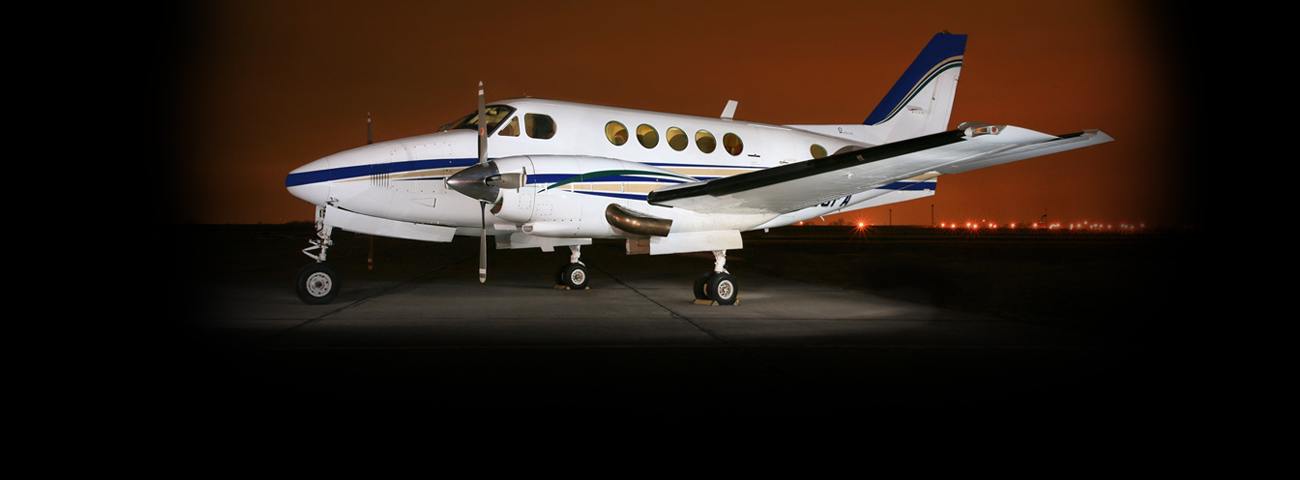1976 - 1983 King Air B100


The Model 100 is a stretched derivative of the Model 90 featuring five cabin windows instead of the Model 90's three; MTOW increased by 1,300 lb (590 kg) over the 90, to 10,600 lb (4,810 kg). The 100 used the wings, tail, and engines (two PT6A-28 engines rated at 620 shp) from the Model 99 airline, itself a development of the Queen Air (as was the Model 90). The Model 100 was flown for the first time on 17 March 1969 and unveiled to the public in May. 89 Model 100s were built before it was superseded by the Model A100 in 1972, with a further increase in MTOW to 11,500 lb (5,220 kg), fuel capacity increased by 94 US Gallons (357 litres), and four-bladed propellers. A total of 157 A100's were built by the time production of this model ceased in 1979. The next in the series was the B100, which featured 715 shp (533 kW) Garrett AiResearch TPE-331 engines as an alternative to the Pratt & Whitneys offered on other King Airs, and another increase in MTOW to 11,800 lb (5,350 kg). The B100 was introduced in 1976 and was produced concurrently with the A100 for several years; manufacture ceased in 1983 after 137 were built. The Model 200 Super King Air was developed from the Model 100, with the same fuselage design (with some differences, mainly associated with the different tails) being used for both models. The Model 200 had different wings and a T-tail and entered service in 1974.

Aircraft Information
| Year: |
1976 - 1983 |
| Make: |
King Air |
| Model: |
B100 |
| Active Fleet: |
119 - For Sale/Lease: 14
|
| Average Asking Price - February 2014: |
$637,000 |
| Range: |
820 - 1,120 nm |
| Contact Number: |
1-847-726-5000 |
| Current Market Price / Availability: |
REQUEST MARKET UPDATE REPORT |
General Performance & Specifications
| Cabin Height: |
4.8 Feet |
| Cabin Width: |
4.5 Feet |
| Cabin Length: |
16.7 Feet |
| Baggage Volume Internal: |
54.0 Cubic Feet |
| Seats Executive: |
*2/6 |
| Max. Take-Off Weight: |
11,800 lbs. |
| Max. Landing Weight: |
11,210 lbs. |
| Maximum Payload: |
1,540 lbs. |
| Balance Field Length: |
3,050 Feet |
| Landing Distance: |
5,650 Feet |
| Rate of Climb - All Engines: |
2,140 Feet / Minute |
| Rate of Climb - One Engine Out: |
500 Feet / Minute |
| Normal Cruise Speed: |
258 ktas |
| Max. Cruise Speed: |
265 ktas |
| Service Ceiling Max. Weight: |
28,000 Feet |
| Number of Engines: |
2 |
| Engine Manufacturer: |
Honeywell |
| Engine Model: |
TPE331-6-252B |
Description
The Model 100 is a stretched derivative of the Model 90 featuring five cabin windows instead of the Model 90's three; MTOW increased by 1,300 lb (590 kg) over the 90, to 10,600 lb (4,810 kg). The 100 used the wings, tail, and engines (two PT6A-28 engines rated at 620 shp) from the Model 99 airline, itself a development of the Queen Air (as was the Model 90). The Model 100 was flown for the first time on 17 March 1969 and unveiled to the public in May. 89 Model 100's were built before it was superseded by the Model A100 in 1972, with a further increase in MTOW to 11,500 lb (5,220 kg), fuel capacity increased by 94 US Gallons (357 litres), and four-bladed propellers. A total of 157 A100's were built by the time production of this model ceased in 1979. The next in the series was the B100, which featured 715 shp (533 kW) Garrett AiResearch TPE-331 engines as an alternative to the Pratt & Whitneys offered on other King Airs, and another increase in MTOW to 11,800 lb (5,350 kg). The B100 was introduced in 1976 and was produced concurrently with the A100 for several years; manufacture ceased in 1983 after 137 were built. The Model 200 Super King Air was developed from the Model 100, with the same fuselage design (with some differences, mainly associated with the different tails) being used for both models. The Model 200 had different wings and a T-tail and entered service in 1974.
















